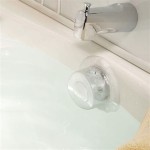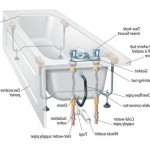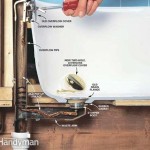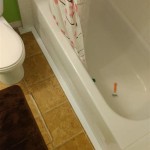Sealant for Bathtub Spout Diverter: A Comprehensive Guide
The bathtub spout diverter is a critical component of the shower-tub system, responsible for redirecting water flow between the tub spout and the showerhead. Over time, the diverter mechanism, or the connection between the spout and the wall, can develop leaks, leading to wasted water, potential water damage behind the wall, and reduced water pressure at the showerhead. Selecting the appropriate sealant for a bathtub spout diverter is essential for creating a watertight seal, preventing leaks, and ensuring the proper functioning of the plumbing system.
This article provides a comprehensive guide to choosing and applying sealant for bathtub spout diverters, covering various types of sealants, crucial considerations for selection, preparation techniques, application methods, and troubleshooting common issues. A thorough understanding of these aspects will facilitate the successful repair or replacement of a leaking spout diverter.
Understanding the Bathtub Spout Diverter and Potential Leak Points
The bathtub spout typically features a pull-up or pull-down diverter that actuates a valve within the spout. This valve redirects the water flow. Potential leak points associated with a bathtub spout diverter include:
The Connection to the Water Supply Pipe: This is the most frequent source of leaks. The spout is typically threaded onto a pipe nipple extending from the wall. If the threads are worn, corroded, or improperly sealed, water can escape.
The Diverter Mechanism Itself: The internal valve that redirects water can wear out or become damaged over time, leading to leaks, especially when the diverter is engaged.
The Spout Body: Cracks or fractures in the spout body, although less common, can also cause leaks.
Identifying the specific leak point is the first step in determining the appropriate sealant and repair method. A careful visual inspection is usually sufficient to pinpoint the source of the leak.
Types of Sealants Suitable for Bathtub Spout Diverters
Several types of sealants are appropriate for use on bathtub spout diverters, each with its own set of advantages and disadvantages. The best choice depends on the specific application, the materials being joined, and the environmental conditions.
Plumber's Putty: This is a pliable, clay-like substance that is primarily used for creating a watertight seal around drains and faucets. It remains flexible and does not harden, making it easy to remove and reapply. However, plumber's putty is not a true sealant and should not be the sole means of creating a watertight seal on a threaded connection. It is best used in conjunction with other sealants or Teflon tape.
Teflon Tape (Thread Seal Tape): This thin, non-adhesive tape is wrapped around the threads of a pipe fitting to create a watertight seal. Teflon tape is inexpensive, easy to apply, and resistant to chemicals and solvents. It is commonly used on threaded connections, including those of bathtub spouts. However, it does not fill gaps, so it is most effective on tightly fitting threads.
Pipe Joint Compound (Pipe Dope): This is a thick, paste-like substance that is applied to the threads of a pipe fitting to create a watertight seal. Pipe joint compound is more effective than Teflon tape at filling gaps and creating a durable seal. Some formulations contain Teflon particles for enhanced sealing performance. It is generally considered a more robust option for sealing threaded connections than Teflon tape alone.
Silicone Caulk: Silicone caulk is a flexible, waterproof sealant that is commonly used for sealing gaps and joints in bathrooms and kitchens. It is resistant to mold and mildew, making it a good choice for wet environments. However, silicone caulk is not typically used on threaded connections, as it is not designed to provide the necessary lubrication and sealing properties. Its primary use is for sealing the perimeter of the spout where it meets the wall, preventing water from seeping behind the fixture.
Threadlocker: While primarily designed to prevent loosening of threaded fasteners, some threadlocker compounds can also provide a sealant effect. These are typically anaerobic adhesives that cure in the absence of air, filling the gaps between threads and creating a strong, vibration-resistant bond. Threadlockers are typically not used for standard bathtub spout installations, but may be appropriate in specific, high-stress applications.
Key Considerations for Sealant Selection
Choosing the right sealant for a bathtub spout diverter involves considering several factors to ensure a long-lasting and effective seal.
Material Compatibility: The sealant must be compatible with the materials being joined. For example, some sealants may corrode certain metals or degrade plastic components. Check the sealant manufacturer's specifications to ensure compatibility with the spout material (typically brass or chrome-plated brass) and the pipe material (typically copper or galvanized steel).
Water Resistance: The sealant must be waterproof to prevent leaks. It should also be resistant to chemicals and detergents that may be present in the water supply.
Flexibility: The sealant should be flexible enough to accommodate minor movement and vibration without cracking or losing its seal. This is particularly important in threaded connections that may experience thermal expansion and contraction.
Ease of Application: The sealant should be easy to apply and work with. Some sealants require special tools or techniques, while others can be applied with a brush or applicator. Consider the level of skill and experience required for proper application.
Temperature Resistance: The sealant should be able to withstand the temperature range of the water supply. Hot water can cause some sealants to soften or degrade.
Longevity: The sealant should provide a long-lasting seal that does not require frequent replacement. Choose a high-quality sealant from a reputable manufacturer.
Ease of Removal: While a durable seal is desirable, the sealant should also be relatively easy to remove if the spout needs to be replaced or repaired in the future. Some sealants form a very strong bond that can be difficult to break.
Preparation and Application Techniques
Proper preparation and application techniques are crucial for ensuring a successful seal. The following steps outline the recommended procedure for sealing a bathtub spout diverter.
Shut Off the Water Supply: Locate the shut-off valves for the hot and cold water lines that supply the bathtub. Turn off both valves to prevent water from flowing to the spout.
Remove the Old Spout: If replacing an existing spout, carefully remove the old one. This typically involves unscrewing the spout from the pipe nipple. If the spout is stuck, use a wrench or pliers to loosen it, but be careful not to damage the pipe or the wall.
Clean the Pipe Nipple: Thoroughly clean the pipe nipple extending from the wall. Remove any old sealant, corrosion, or debris. Use a wire brush or abrasive pad to clean the threads, ensuring a clean surface for the new sealant to adhere to.
Apply Teflon Tape or Pipe Joint Compound: If using Teflon tape, wrap it around the threads of the pipe nipple in a clockwise direction, overlapping each layer slightly. Apply several layers of tape to ensure a good seal. If using pipe joint compound, apply a thin, even layer to the threads of the pipe nipple using a brush or applicator. Avoid applying too much compound, as this can make it difficult to tighten the spout.
Install the New Spout: Carefully screw the new spout onto the pipe nipple, tightening it by hand until it is snug. Use a wrench or pliers to tighten it further, but be careful not to overtighten, as this can damage the spout or the pipe. The spout should be oriented correctly, with the diverter handle facing upwards or downwards, depending on the design.
Apply Silicone Caulk (Optional): If desired, apply a bead of silicone caulk around the perimeter of the spout where it meets the wall. This will help to prevent water from seeping behind the fixture. Smooth the caulk with a wet finger or tool to create a clean, professional finish.
Turn On the Water Supply: Slowly turn on the hot and cold water supply valves. Check for leaks around the spout and the diverter mechanism. If leaks are present, tighten the spout slightly or reapply sealant as needed.
Troubleshooting Common Problems
Even with careful preparation and application, leaks can still occur. Here are some common problems and their solutions:
Leaks at the Threaded Connection: This is the most common problem. If leaks are present at the threaded connection, try tightening the spout slightly. If this does not solve the problem, remove the spout, clean the threads, and reapply Teflon tape or pipe joint compound.
Leaks from the Diverter Mechanism: If leaks are coming from the diverter mechanism itself, the valve may be worn or damaged. In this case, the spout may need to be replaced. Some spouts have replaceable diverter cartridges, which can be a more economical solution.
Water Seeping Behind the Spout: This indicates that water is penetrating the gap between the spout and the wall. Apply a bead of silicone caulk around the perimeter of the spout to seal the gap.
Difficulty Tightening the Spout: If the spout is difficult to tighten, the threads may be damaged or corroded. Clean the threads thoroughly and apply a lubricant, such as Teflon tape or pipe joint compound, to help ease the tightening process. If the threads are severely damaged, the pipe nipple may need to be replaced.
Spout Won't Stay Tight: This can be due to worn threads on either the spout or the pipe nipple. Using a more robust sealant, such as pipe joint compound with Teflon, might provide a better grip. If the problem persists, replacing either the spout or the pipe nipple is recommended.

How To Install Red Disc Seal Protect Your Bathtub Wall Prevent Drywall Damage Www Reddiscseal Com

How To Install A Tub Spout The Home Depot

How To Fix A Failed Tub Spout Seal Diy Friendly Task

How To Seal Tub Spout And Valve Trim With Silicone Caulking The Fixer Clips

Bathtub Spout With Diverter Replacement Fix Leaking Tub Jonny Diy

Everbilt Tub Spout Diverter Repair Kit 865320 The Home Depot

1 2 Bathtub Spout Back Sealing Bathroom Finished Wall Protection From Water Leakage Bath Leaking Prevention Disc Seal Block For Shower

How To Fix A Shower Diverter Repair Or Replace

Tub Spout Back Seal Bath Protect Finished Wall From Water Leakage Disc For 1 2 Copper Pipe Od 0 63 16mm1 Flibyt Bathtub

Plumbing New Bathtub Diverter Spout Drains Back Into Wall Home Improvement Stack Exchange








